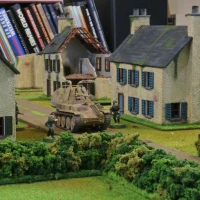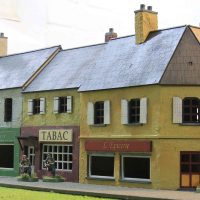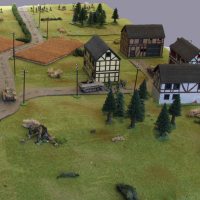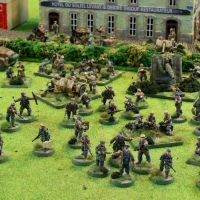
After I realised, that this would be the 100th post on this blog (1st anniversary, 50.000 hits and 100th post all within 2 1/2 weeks) it was easy to decide what to post today. Something that is big, so it had to be tanks.

T-26
First up is a T-26. The model is a 1:56th scale from Chieftain (back when they still belonged to Crouchie) and is quiet heavy, being cast in all white metal. In reality it weighted around ten tons and was produced from 1931 till ´41. It saw use during the Spanish Civil War and with the Soviets till the end of the war. With over 12.000 (including all variants) vehicles produced it was the most successful design of the 1930´s.

T-70s
These are my T-70s. All three are JFTM / Die Waffenkammer 1:56th scale models, as is the commander. The T-70 light tank was designed as a replacement for the T-60. The Soviets had no real love for light tanks, since they were usually no faster than the T-34, but weaker in armour and firepower. On the other hand there were still a number of factories that were too small to produce T-34s and with every tank needed to defend the motherland these were used for light tanks still. The T-70 was one of them and between 1942 and ´43 8.226 were produced. With its 45mm gun it could not hope to take out a Panther or Tiger or even a PzKw IV (from the front), but it was still a serious threat to the PzKw III and lighter vehicles.

SU-76s

SU-76 crew compartments
Again these two are from JFTM / Die Waffenkammer, as are the crews. Design of the SU-76 began in November 1942, when the State Defense Committee ordered the construction of infantry support self-propelled guns armed with the ZiS-3 76.2mm gun. It used the basic T-70 chassis, which was lengthened by adding one road wheel per side, to facilitate better gun mounting.
Just like the early T-70 models the SU-76 utilized two automobile engines, one for each track. Apart from being complicated to drive, the strong vibrations led to early failures of engines and transmission units. After producing 320 SU-76s, mass production was halted in order to fix the problems. This included the change over to th single engine now standard on the T-70, as well as the removal of the roof of the compartment (the first models were completely enclosed by armour). This final version was produced till shortly after the war when they were withdrawn from service, with a total of nearly 13.000 units (making it the second most common vehicle in the soviet arsenal after the T-34).

SU-76i
This model is a 1:48th scale Tamiya with an aftermarket conversion kit to turn it into a SU-76i. The production halt and redesign of the SU-76 was the reason for the introduction of the SU-76i. Tank destroyers of all types were in very short supply and with the SU-76 production halted and interim was needed. Approximately 200 PzKpfw IIIs and StuG IIIs were available to the Soviets, most having been captured during the German retreat from Stalingrad, and so it was decided to use these as the basis for a Soviet tank destroyer, the SU-76i.
The conversion from PzKpfw III to SU-76i began with the removal of the turret, and fighting compartment roof. A new, angular superstructure was welded in place and mounted the 76,2mm gun. The guns mostly came from KV-1, which were being rearmed with the 85mm cannon at about the same time. The chassis used were from the PzKw III Ausf. H and J, the majority being Ausf. J. Since it was incapable of indirect fire (unlike the SU-76), its gun was nearing the end of its effectiveness, spare parts were hard to get and the SU-76 production was up again, these vehicles only saw a short service life, with only a few if any at all still seeing use in 1944.

SU-85 and SU-122
The SU-85 is a Bandai kit, the SU-122 a Tamiya, both 1:48th scale.
The SU-85 was a tank destroyer based on the T-34 chassis. Up until late 1942 the T-34/76 and KV-1s had been able to deal with any tank the Germans had in their arsenal. This changed with the introduction of the Tiger. To add to this there were rumors of the Panther as well and the Soviets felt they needed something bigger. This saw the creation of the SU-85 by mating a 85mm gun with a turret-less T-34 chassis. 2.050 units were built from mid-1943 to late 1944.
The SU-122 was meant to be used against installations or infantry formations. It mounted a 122mm howitzer, again on a T-34 chassis. While the gun only fired HE ammunition, it was still enough to punch through the armour on a PzKw III or IV. There are also reports the hits at very short-range were able to lift the turret of its ring on a Tiger or Panther, although they had no chance at long ranges. A total 1.150 were build between December 1942 and the summer of ´44.

KV-1 and KV-2
Both of these models are 1:48th scale Tamiya models, the tanker is from Bolt Action.
When Germany invaded the Soviet Union both the KV-1 and KV-2 came as nasty surprises. The German high command had not expected the Soviets to have such heavy tanks and even more critical with such heavy armour. The 3,7cm and 5cm PaKs were unable to penetrate them, as were the short 7,5cm guns on the PzKw IV and StuG III, they heaviest tank mounted weapons the Germans had at that time. Often artillery in direct-fire mode or the notorious Acht-Achter Flak had to be brought up. Otherwise there are lots of tales of German Panzer trying to score immobilizing hits so that the infantry could crawl up and disable them explosives. Hardly a help for the Blitzkrieg.
The KV-1 weighted in at 45 tonnes, used the same 76mm gun as did the T-34 and saw service up till the end of the war (although later up-gunned to 85mm). Total of 5.219 units were produced.
The KV-2 was a monster at 53,1 tonnes. although its designation suggests otherwise, it is actually the older of the two. Only about 250 units were build. While it saw use till the end of the war, it is highly unlikely that any served in front line formations after production ceased. It was just too slow and offered an easy target with its big turret once the Germans had guns big enough to take it out. The 152mm howitzer took ages to reload and with the slow turret speed was useless against tanks. Even worse the weight of the turret was so big, that it was impossible to turn it when the tank was on anything but a mild slope. It had its good moments like on 23rd and 24th June 1941, when a single KV-2 of 2nd tank division held up the German 6th Panzer Division in southern Lithuania (near Rassaynjay town), but those were few.

KV-1 and SU-122 in winter whitewash
Here are another KV-1 and SU-122 in winter whitewash, again Tamiya models. I removed the boards from the KV-1. I had found a wartime photo of one like this (apparently to prevent the mud from accumulating under them when the thaw began) and I felt it looked so cool it needed to be reproduced.

T-34/76 winter whitewash
All three models are 1:48th scale Bandai models. I got all three quite cheap and decided to do them in a whitewash. They are usually expensive to get and are slightly smaller than the Tamiya and Hobby Boss offerings, so I decided I would not have tem on the table at the same time anyway.

T-34/76s
All these are 1:48th scale models. Left Hobby Boss, middle Tamiya with after market armour (Leningrad factories) and right Tamiya. The crews are Bolt Action and converted Mongrel Miniatures.

T-34/76s (hexagonal turret)
Again all 1:48th scale, except for the one in the middle, which is a Tamiya with aftermarket parts and Bolt Action / Mongrel Miniatures crew, all are Hobby Boss.

T-34/76s (hybrid)
These two are 1:48th scale Hobby Boss T-34/85s with Tamiya T-34/76 turrets. Thess bring me up to a total of ten T-34/76 if needed!
Just like the KV series tanks, the T-34 was a nasty surprise for the Germans in the summer of 1941. They were expecting an inferior enemy with inferior tanks, but found that the Soviets had a huge number of T-34s as well. While their armour was not as strong as the KVs, the fact that it was sloped set that off. So again the Acht-Achter or artillery was needed to destroy them. Against popular believe the Russians had quiet a number of them when the Germans attacked. What actually happened to these is a bit shrouded in mystery. Soviet reports state rapidly decreasing numbers, while German reports indicate few encounters with them. Which must mean that a lot of them were non-combat losses. By the time this reliability problem had been solved in 1942, the Germans had more weapons that were able to take them out though.
None the less the T-34 was a great tank. Cheap and easy to build and maintain, good speed, high cross-country performance even when the muddy season began. It began the war with a 76,2 mm cannon and was later up-gunned to a 85mm. Its armour remained en-par with the PzKw IV or Sherman, and only paled in comparison to the Panther and Tiger. It had hardly any creature comforts for the crew, but proved so effective that 84.070 units were produced until production ceased in 1958. But a good number of them are still in use. The North Koreans actually had a number of regiments armed with them at th turn of the millennium and probably do so today (although most likely the 85mm version).

T-34/85s
These three T-34/85s are Hobby Boss 1:48th scale models with Bolt Action / Mongrel Miniatures crew. You already saw two of them in the previous photo. I guess I might have to get myself a few more later.

JS-2s
And last two 1:48th scale JS-2s from Hobby Master with a JFTM / Die Waffenkammer commander. The one on the right was repainted.
The Josef Stalin tank , was a heavy tank designed with thick armour to counter the German 88 mm guns, and carried a main gun that was capable of defeating the German Tiger and Panther tanks. The JS-2 was put into service in April 1944, and was used as a spearhead in the Battle of Berlin in its intended role of breakthrough tank, firing a heavy high-explosive shell that was useful against entrenchments and bunkers. But its massive 122mm main gun was also more than capable of taking out the mighty Tiger II. A total of 3.854 units were produced and used till 1995 (although I suspect North Korea still uses hers).
And this is it… my Soviet armour. just to give you a parting shot… here they are all together. And no this is not 15mm FOW, this really is 28mm!!!

Soviet Armour
(I have uploaded a high quality picture here, so it well worth clicking onto it!)
P.S.: I managed to set up the “Categories” listing the way I wanted it after all, so feel free to browse a little through the older entries.



















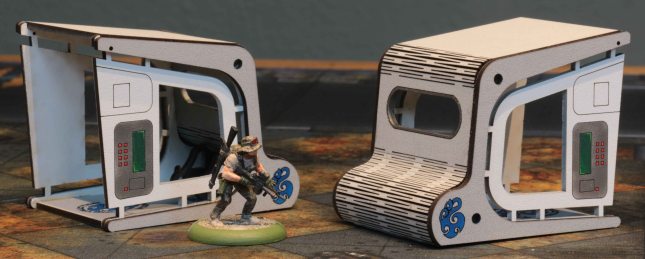










![Königstiger [Wartanks] Königstiger [Wartanks]](https://dhcwargamesblog.files.wordpress.com/2012/07/kc3b6nigstiger-wartanks.jpg?w=516&h=225)
![Königstiger [Tamiya] Königstiger [Tamiya]](https://dhcwargamesblog.files.wordpress.com/2012/07/kc3b6nigstiger-tamiya.jpg?w=516&h=344)

![Königstiger [Tamiya - Berlin] Königstiger [Tamiya - Berlin]](https://dhcwargamesblog.files.wordpress.com/2012/07/kc3b6nigstiger-tamiya-berlin.jpg?w=516&h=249)
![Königstiger [Hobbymaster] Königstiger [Hobbymaster]](https://dhcwargamesblog.files.wordpress.com/2012/07/kc3b6nigstiger-hobbymaster.jpg?w=516&h=230)
![Königstiger [front view] Königstiger [front view]](https://dhcwargamesblog.files.wordpress.com/2012/07/kc3b6nigstiger-front-view.jpg?w=516&h=137)
![Königstiger [top view] Königstiger [top view]](https://dhcwargamesblog.files.wordpress.com/2012/07/kc3b6nigstiger-top-view.jpg?w=516&h=327)
![Königstiger [rear view] Königstiger [rear view]](https://dhcwargamesblog.files.wordpress.com/2012/07/kc3b6nigstiger-rear-view.jpg?w=516&h=130)






















































